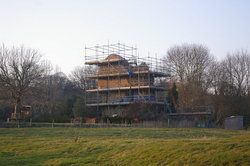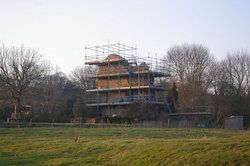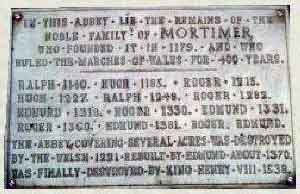In December 1260, Roger had a license to take game and to fish along the Thames and its tributaries. The whole of the years 1262 and 1263 he spent in fighting Llewelyn with varying success. On 6 April 1264 he was with the King at the taking of Northampton, and captured a number of prisoners.
Shortly before Prince Edward sailed for the Holy Land, August 1270, Roger was made one of the trustees for the Prince's estates during his absence on the Crusade.
In 1279, he held a splendid tournament at Kenilworth. On 27 Oct 1282 the King ordered, "as a special favor which has never been granted before," that if Roger should die during his present illness, the executors of his will should not be impeded by reason of his debts to the Exchequer.
Roger married, in 1247, Maud, eldest daughter and coheir of William de Braose, by Eve, sister and coheir of Walter Marshall, Earl of Pembroke, Marshal of England, daughter of William Marshal and Isabel de Clare. Roger died shortly before 30 Oct 1282, at Kingsland, Hereford, and was buried at Wigmore, being aged about 50, and in harness to the end. His widow Maud had various instructions during the Welsh wars, as had other barons of the March. In 1292 she had protection, as staying in Wales on the King's service. She died shortly before 23 March 1300/ 1, when the writ to the escheator issued
In 1303, a further inquisition was taken on the lands of Roger and Maud. Their children: their heir Edmund, William, who was hostage for his father in Aug 1264, and married Hawise, daughter and heir of Robert de Muscegros, and died shortly before June 1297. Margaret, who was to married Robert de Vere, and Isabel married John Fitz Alan.
Roger Mortimer died on October 30, 1282, and was buried at Wigmore Abbey, where his tombstone read:
Here lies buried, glittering with praise, Roger the pure, Roger Mortimer the second, called Lord of Wigmore by those who held him dear. While he lived all Wales feared his power, and given as a gift to him all Wales remained his. It knew his campaigns, he subjected it to torment.
In December 1260, Roger had a license to take game and to fish along the Thames and its tributaries. The whole of the years 1262 and 1263 he spent in fighting Llewelyn with varying success. On 6 April 1264 he was with the King at the taking of Northampton, and captured a number of prisoners.
Shortly before Prince Edward sailed for the Holy Land, August 1270, Roger was made one of the trustees for the Prince's estates during his absence on the Crusade.
In 1279, he held a splendid tournament at Kenilworth. On 27 Oct 1282 the King ordered, "as a special favor which has never been granted before," that if Roger should die during his present illness, the executors of his will should not be impeded by reason of his debts to the Exchequer.
Roger married, in 1247, Maud, eldest daughter and coheir of William de Braose, by Eve, sister and coheir of Walter Marshall, Earl of Pembroke, Marshal of England, daughter of William Marshal and Isabel de Clare. Roger died shortly before 30 Oct 1282, at Kingsland, Hereford, and was buried at Wigmore, being aged about 50, and in harness to the end. His widow Maud had various instructions during the Welsh wars, as had other barons of the March. In 1292 she had protection, as staying in Wales on the King's service. She died shortly before 23 March 1300/ 1, when the writ to the escheator issued
In 1303, a further inquisition was taken on the lands of Roger and Maud. Their children: their heir Edmund, William, who was hostage for his father in Aug 1264, and married Hawise, daughter and heir of Robert de Muscegros, and died shortly before June 1297. Margaret, who was to married Robert de Vere, and Isabel married John Fitz Alan.
Roger Mortimer died on October 30, 1282, and was buried at Wigmore Abbey, where his tombstone read:
Here lies buried, glittering with praise, Roger the pure, Roger Mortimer the second, called Lord of Wigmore by those who held him dear. While he lived all Wales feared his power, and given as a gift to him all Wales remained his. It knew his campaigns, he subjected it to torment.
Inscription
Here lies buried, glittering with praise, Roger the pure, Roger Mortimer the second, called Lord of Wigmore by those who held him dear. While he lived all Wales feared his power, and given as a gift to him all Wales remained his. It knew his campaigns, he subjected it to torment.







